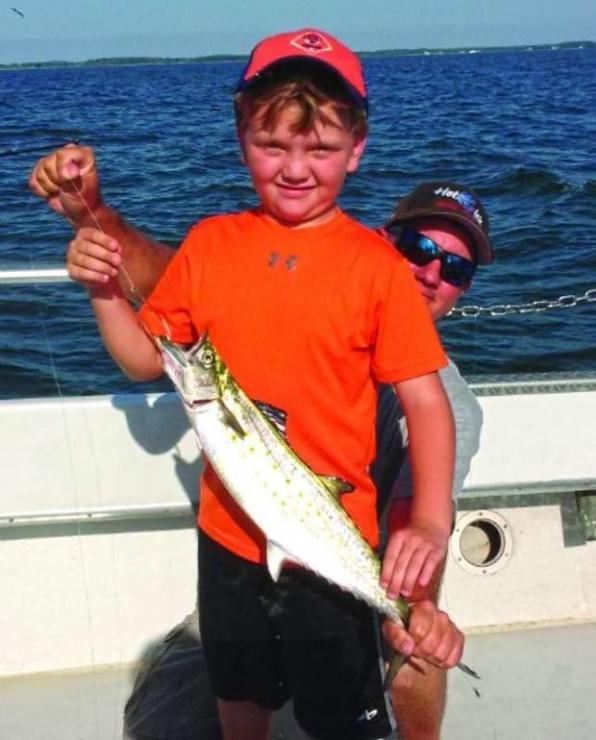
Joaquin is now a full-blown hurricane (at least temporarily as I write this month’s column) and has its sights set on the Bahamas, with a potential tour of the Mid Atlantic. If it does head our way, that should shake up the ocean and surf fishing. Once things settle back down, it could make for some stellar action. Bluewater anglers fishing the canyons should do well on the tuna, wahoo, and mahi trolling their favorite rig, such as a skirted or naked ballyhoo or spreader bars.
The bull red drum that entertained Upper Bay anglers for the past month and a half are making their way south, as are the Spanish mackerel which arrived in August and stayed through most of September. Bluefish still have some unsettled business with anchovies, and certainly the croakers will be long gone, at least in Maryland waters, by the time this issue hits the streets.
If skinny water and breaking fish are your thing, this is the best time of the year. Stripers and remaining bluefish will crash anchovies and menhaden, and if they’re around, speckled trout and puppy drum will light up your topwater plug or swim bait. So, the only way to know for sure whether or not any of these predictions become reality is to get out on the water. Good luck and stay safe.
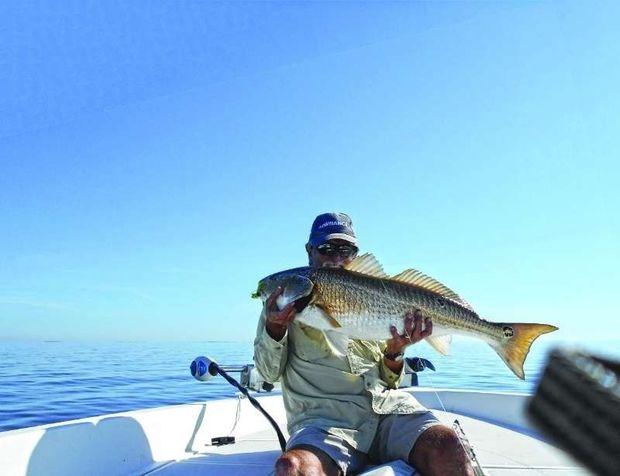 Delmarva Coast
Eric Burnley
Delmarva Coast
Eric Burnley says beginning in the middle of October we should see the first signs of the fall rockfish run in Delaware Bay.
“The upper bay has traditionally seen the earliest fish with chunkers working the channel edge out of Collins Beach or Woodland Beach finding the most action,” he predicts. “Fresh bunker is the one and only bait worth using. Frozen may be used if nothing fresh is available. The best bite occurs during periods of moving water.”
Eric says the early November action may move to the rips at the mouth of the bay and here “trolling is king. Pulling Stretch 25s or 30s is the top technique, with big spoons such as the Huntington Drone 3-1/2 or 4-1/2 two good choices.” He adds that plugs will work fine on regular mono or braid trolling outfits, while the spoons do their best work on wire line. And, he reminds us, “live eels will work, but seldom on slack water when dog sharks feed with reckless abandon.”
Captain Monty Hawkins of the party boat Morning Star is coming off a solid summer season, in which his anglers caught nice flounder and even mahi. He’s currently prepping the boat for the opening of the sea bass season, which happens October 22. “We’ll be chasing sea bass (aka blackfish) through early December—as good as it’s going to get with 15-fish limit,” he says.
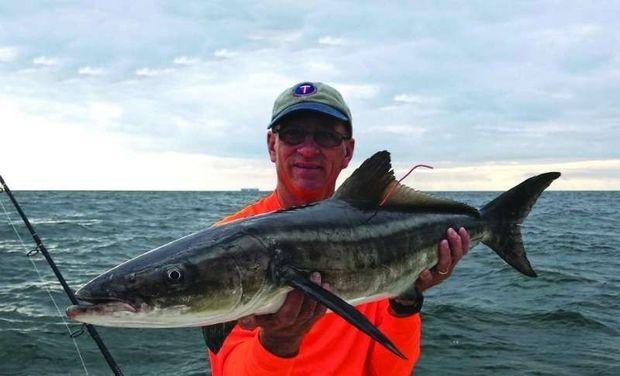 Maryland Chesapeake
Captain Tyler Nonn of Tidewater Charters
Maryland Chesapeake
Captain Tyler Nonn of Tidewater Charters predicts the rockfishing should only get better. He suggests keeping an eye out for fish to transition into your typical fall patterns as water temps begin to drop into the 60s, 50s, and lower.
“Early morning top water bites will continue on major river mouth points, shoals, and hard bottoms. Medium size top water baits in the three-to-five-inch range should produce decent fish,” he suggests. “To save time unhooking fish and not to beat up fish too bad, try replacing treble hooks with singles or take off the front hook completely. Light tackle fishermen and fly fishermen look forward to the crisp mornings surrounded by fish before winter takes hold.”
Captain Tyler adds that fishermen “can cross their fingers and hope to see an early migratory fish or two this time of the year as well. So while you can, get out on the water and enjoy some fall Chesapeake Bay fishing.”
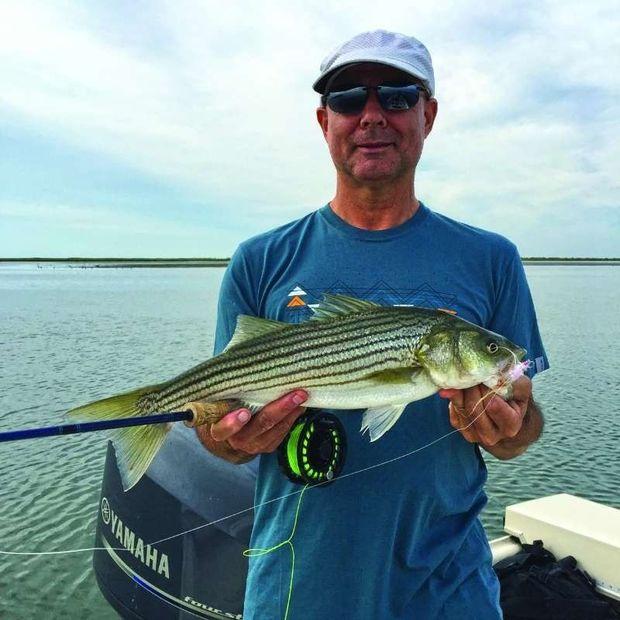
“November is my favorite time of year for Tangier Sound rockfish,” proclaims fly and light tackle fisherman
Captain Kevin Josenhans. “Rockfish can be caught using a broad range of techniques. From plying the shallows with Clouser Deep Minnows or Hogy Bunny Swim Baits, to casting to breakers or deep-jigging the channel edges with Li’l Jimys and Li’l Bunker lures by Specialized Baits. Rockfish are fat and hungry as winter approaches and will eagerly engulf most any offering within range.”
Captain Kevin suggests you try the deep water tidal creeks of Smith, South Marsh, and Bloodsworth Islands, which typically will hold tightly packed schools of stripers “gorging themselves on small crabs and mud minnows. Match the size of fly or lure to the bait for best success.”
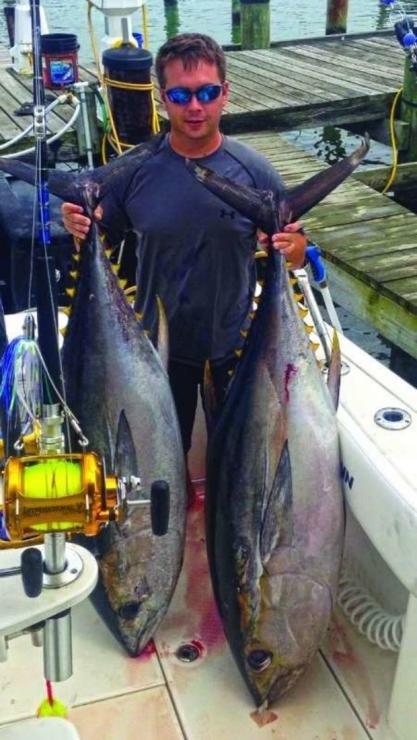 Virginia Chesapeake
Virginia Chesapeake
According to
Ric Burnley don’t let a little autumn chill chase you off the water, especially for anglers in Southeast Virginia and the Outer Banks.
“Inshore anglers will be in (their) glory, as speckled trout and redfish make their way down the coast. All of the local rivers, bays, and surf spots will fill with these fish while they gorge for the winter migration,” he suggests. “Look for redfish in the skinny water and around structures such as oyster beds and dock pilings. Speckled trout like to hang where current will sweep over a structure like a channel edge or sandbar and bring in a meal.”
Ric says a sure bet is casting soft plastics on a leadhead jig, but bigger fish will respond to twitch baits and topwater lures.
“Striper season opens and anglers will pull schoolie striped bass from bridge pilings and rock islands of area bridges and tunnels. Bounce a one- to two-ounce bucktail off the bottom or cast a three- to five-inch swim shad into the structure to find stripers,” he recommends. “Or, look for the fish feeding under diving gulls. Big red drum will move down the coast providing a great target for surf and nearshore anglers. Look for schools of big reds feeding on the surface and cast a two-ounce bucktail or seven-inch swim shad. Or, soak a chunk of menhaden or spot on a fishfinder rig along drops and bars to score trophy redfish.
Offshore, Ric predicts fishing will heat up as the weather cools. “Expect tuna, wahoo, and the season’s last mahi to work the edge of the Continental Shelf. Troll skirted ballyhoo, naked ballyhoo, and spreader bars to score offshore gamefish in the fall.”
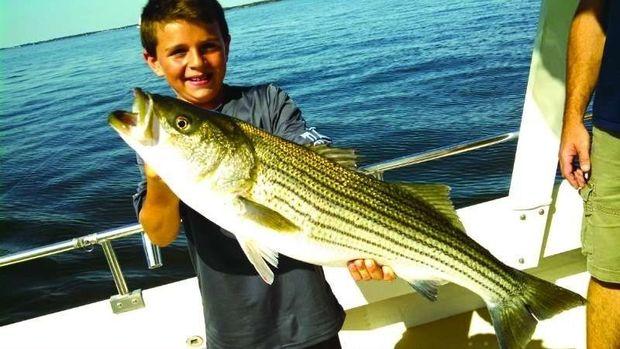 Captain Walt of Light Tackle Charters
Captain Walt of Light Tackle Charters says November is a great time to target schooling striped bass, especially in his home waters around the Maryland/Virginia line area of the Chesapeake.
“We start with locating the feeding schools under birds—gulls, pelicans, gannets—diving onto the bait right on the surface of the water. Then cast single hooked lures (my favorites are Storms, Bucktails, and Jigs tipped with plastics) toward the frenzy, taking care not to wrap your line around any birds,” he suggests.
“When we start catching, we determine the size of the fish feeding on the surface. If we’re happy with their size, we continue that strategy. If we’re not happy with their size, we move “down tide” of the surface activity and jig deeper with single hook metal lures; my favorites are Sting Silvers and Crippled Herring seeking the bigger rockfish feeding on the carnage falling in the water column.”
by Captain Chris D. Dollar Joaquin is now a full-blown hurricane (at least temporarily as I write this month’s column) and has its sights set on the Bahamas, with a potential tour of the Mid Atlantic. If it does head our way, that should shake up the ocean and surf fishing. Once things settle back down, it could make for some stellar action. Bluewater anglers fishing the canyons should do well on the tuna, wahoo, and mahi trolling their favorite rig, such as a skirted or naked ballyhoo or spreader bars.
The bull red drum that entertained Upper Bay anglers for the past month and a half are making their way south, as are the Spanish mackerel which arrived in August and stayed through most of September. Bluefish still have some unsettled business with anchovies, and certainly the croakers will be long gone, at least in Maryland waters, by the time this issue hits the streets.
If skinny water and breaking fish are your thing, this is the best time of the year. Stripers and remaining bluefish will crash anchovies and menhaden, and if they’re around, speckled trout and puppy drum will light up your topwater plug or swim bait. So, the only way to know for sure whether or not any of these predictions become reality is to get out on the water. Good luck and stay safe.
Joaquin is now a full-blown hurricane (at least temporarily as I write this month’s column) and has its sights set on the Bahamas, with a potential tour of the Mid Atlantic. If it does head our way, that should shake up the ocean and surf fishing. Once things settle back down, it could make for some stellar action. Bluewater anglers fishing the canyons should do well on the tuna, wahoo, and mahi trolling their favorite rig, such as a skirted or naked ballyhoo or spreader bars.
The bull red drum that entertained Upper Bay anglers for the past month and a half are making their way south, as are the Spanish mackerel which arrived in August and stayed through most of September. Bluefish still have some unsettled business with anchovies, and certainly the croakers will be long gone, at least in Maryland waters, by the time this issue hits the streets.
If skinny water and breaking fish are your thing, this is the best time of the year. Stripers and remaining bluefish will crash anchovies and menhaden, and if they’re around, speckled trout and puppy drum will light up your topwater plug or swim bait. So, the only way to know for sure whether or not any of these predictions become reality is to get out on the water. Good luck and stay safe.
 Delmarva Coast
Eric Burnley says beginning in the middle of October we should see the first signs of the fall rockfish run in Delaware Bay.
“The upper bay has traditionally seen the earliest fish with chunkers working the channel edge out of Collins Beach or Woodland Beach finding the most action,” he predicts. “Fresh bunker is the one and only bait worth using. Frozen may be used if nothing fresh is available. The best bite occurs during periods of moving water.”
Eric says the early November action may move to the rips at the mouth of the bay and here “trolling is king. Pulling Stretch 25s or 30s is the top technique, with big spoons such as the Huntington Drone 3-1/2 or 4-1/2 two good choices.” He adds that plugs will work fine on regular mono or braid trolling outfits, while the spoons do their best work on wire line. And, he reminds us, “live eels will work, but seldom on slack water when dog sharks feed with reckless abandon.”
Captain Monty Hawkins of the party boat Morning Star is coming off a solid summer season, in which his anglers caught nice flounder and even mahi. He’s currently prepping the boat for the opening of the sea bass season, which happens October 22. “We’ll be chasing sea bass (aka blackfish) through early December—as good as it’s going to get with 15-fish limit,” he says.
Delmarva Coast
Eric Burnley says beginning in the middle of October we should see the first signs of the fall rockfish run in Delaware Bay.
“The upper bay has traditionally seen the earliest fish with chunkers working the channel edge out of Collins Beach or Woodland Beach finding the most action,” he predicts. “Fresh bunker is the one and only bait worth using. Frozen may be used if nothing fresh is available. The best bite occurs during periods of moving water.”
Eric says the early November action may move to the rips at the mouth of the bay and here “trolling is king. Pulling Stretch 25s or 30s is the top technique, with big spoons such as the Huntington Drone 3-1/2 or 4-1/2 two good choices.” He adds that plugs will work fine on regular mono or braid trolling outfits, while the spoons do their best work on wire line. And, he reminds us, “live eels will work, but seldom on slack water when dog sharks feed with reckless abandon.”
Captain Monty Hawkins of the party boat Morning Star is coming off a solid summer season, in which his anglers caught nice flounder and even mahi. He’s currently prepping the boat for the opening of the sea bass season, which happens October 22. “We’ll be chasing sea bass (aka blackfish) through early December—as good as it’s going to get with 15-fish limit,” he says.
 Maryland Chesapeake
Captain Tyler Nonn of Tidewater Charters predicts the rockfishing should only get better. He suggests keeping an eye out for fish to transition into your typical fall patterns as water temps begin to drop into the 60s, 50s, and lower.
“Early morning top water bites will continue on major river mouth points, shoals, and hard bottoms. Medium size top water baits in the three-to-five-inch range should produce decent fish,” he suggests. “To save time unhooking fish and not to beat up fish too bad, try replacing treble hooks with singles or take off the front hook completely. Light tackle fishermen and fly fishermen look forward to the crisp mornings surrounded by fish before winter takes hold.”
Captain Tyler adds that fishermen “can cross their fingers and hope to see an early migratory fish or two this time of the year as well. So while you can, get out on the water and enjoy some fall Chesapeake Bay fishing.”
Maryland Chesapeake
Captain Tyler Nonn of Tidewater Charters predicts the rockfishing should only get better. He suggests keeping an eye out for fish to transition into your typical fall patterns as water temps begin to drop into the 60s, 50s, and lower.
“Early morning top water bites will continue on major river mouth points, shoals, and hard bottoms. Medium size top water baits in the three-to-five-inch range should produce decent fish,” he suggests. “To save time unhooking fish and not to beat up fish too bad, try replacing treble hooks with singles or take off the front hook completely. Light tackle fishermen and fly fishermen look forward to the crisp mornings surrounded by fish before winter takes hold.”
Captain Tyler adds that fishermen “can cross their fingers and hope to see an early migratory fish or two this time of the year as well. So while you can, get out on the water and enjoy some fall Chesapeake Bay fishing.”
 “November is my favorite time of year for Tangier Sound rockfish,” proclaims fly and light tackle fisherman Captain Kevin Josenhans. “Rockfish can be caught using a broad range of techniques. From plying the shallows with Clouser Deep Minnows or Hogy Bunny Swim Baits, to casting to breakers or deep-jigging the channel edges with Li’l Jimys and Li’l Bunker lures by Specialized Baits. Rockfish are fat and hungry as winter approaches and will eagerly engulf most any offering within range.”
Captain Kevin suggests you try the deep water tidal creeks of Smith, South Marsh, and Bloodsworth Islands, which typically will hold tightly packed schools of stripers “gorging themselves on small crabs and mud minnows. Match the size of fly or lure to the bait for best success.”
“November is my favorite time of year for Tangier Sound rockfish,” proclaims fly and light tackle fisherman Captain Kevin Josenhans. “Rockfish can be caught using a broad range of techniques. From plying the shallows with Clouser Deep Minnows or Hogy Bunny Swim Baits, to casting to breakers or deep-jigging the channel edges with Li’l Jimys and Li’l Bunker lures by Specialized Baits. Rockfish are fat and hungry as winter approaches and will eagerly engulf most any offering within range.”
Captain Kevin suggests you try the deep water tidal creeks of Smith, South Marsh, and Bloodsworth Islands, which typically will hold tightly packed schools of stripers “gorging themselves on small crabs and mud minnows. Match the size of fly or lure to the bait for best success.”
 Virginia Chesapeake
According to Ric Burnley don’t let a little autumn chill chase you off the water, especially for anglers in Southeast Virginia and the Outer Banks.
“Inshore anglers will be in (their) glory, as speckled trout and redfish make their way down the coast. All of the local rivers, bays, and surf spots will fill with these fish while they gorge for the winter migration,” he suggests. “Look for redfish in the skinny water and around structures such as oyster beds and dock pilings. Speckled trout like to hang where current will sweep over a structure like a channel edge or sandbar and bring in a meal.”
Ric says a sure bet is casting soft plastics on a leadhead jig, but bigger fish will respond to twitch baits and topwater lures.
“Striper season opens and anglers will pull schoolie striped bass from bridge pilings and rock islands of area bridges and tunnels. Bounce a one- to two-ounce bucktail off the bottom or cast a three- to five-inch swim shad into the structure to find stripers,” he recommends. “Or, look for the fish feeding under diving gulls. Big red drum will move down the coast providing a great target for surf and nearshore anglers. Look for schools of big reds feeding on the surface and cast a two-ounce bucktail or seven-inch swim shad. Or, soak a chunk of menhaden or spot on a fishfinder rig along drops and bars to score trophy redfish.
Offshore, Ric predicts fishing will heat up as the weather cools. “Expect tuna, wahoo, and the season’s last mahi to work the edge of the Continental Shelf. Troll skirted ballyhoo, naked ballyhoo, and spreader bars to score offshore gamefish in the fall.”
Virginia Chesapeake
According to Ric Burnley don’t let a little autumn chill chase you off the water, especially for anglers in Southeast Virginia and the Outer Banks.
“Inshore anglers will be in (their) glory, as speckled trout and redfish make their way down the coast. All of the local rivers, bays, and surf spots will fill with these fish while they gorge for the winter migration,” he suggests. “Look for redfish in the skinny water and around structures such as oyster beds and dock pilings. Speckled trout like to hang where current will sweep over a structure like a channel edge or sandbar and bring in a meal.”
Ric says a sure bet is casting soft plastics on a leadhead jig, but bigger fish will respond to twitch baits and topwater lures.
“Striper season opens and anglers will pull schoolie striped bass from bridge pilings and rock islands of area bridges and tunnels. Bounce a one- to two-ounce bucktail off the bottom or cast a three- to five-inch swim shad into the structure to find stripers,” he recommends. “Or, look for the fish feeding under diving gulls. Big red drum will move down the coast providing a great target for surf and nearshore anglers. Look for schools of big reds feeding on the surface and cast a two-ounce bucktail or seven-inch swim shad. Or, soak a chunk of menhaden or spot on a fishfinder rig along drops and bars to score trophy redfish.
Offshore, Ric predicts fishing will heat up as the weather cools. “Expect tuna, wahoo, and the season’s last mahi to work the edge of the Continental Shelf. Troll skirted ballyhoo, naked ballyhoo, and spreader bars to score offshore gamefish in the fall.”
 Captain Walt of Light Tackle Charters says November is a great time to target schooling striped bass, especially in his home waters around the Maryland/Virginia line area of the Chesapeake.
“We start with locating the feeding schools under birds—gulls, pelicans, gannets—diving onto the bait right on the surface of the water. Then cast single hooked lures (my favorites are Storms, Bucktails, and Jigs tipped with plastics) toward the frenzy, taking care not to wrap your line around any birds,” he suggests.
“When we start catching, we determine the size of the fish feeding on the surface. If we’re happy with their size, we continue that strategy. If we’re not happy with their size, we move “down tide” of the surface activity and jig deeper with single hook metal lures; my favorites are Sting Silvers and Crippled Herring seeking the bigger rockfish feeding on the carnage falling in the water column.”
by Captain Chris D. Dollar
Captain Walt of Light Tackle Charters says November is a great time to target schooling striped bass, especially in his home waters around the Maryland/Virginia line area of the Chesapeake.
“We start with locating the feeding schools under birds—gulls, pelicans, gannets—diving onto the bait right on the surface of the water. Then cast single hooked lures (my favorites are Storms, Bucktails, and Jigs tipped with plastics) toward the frenzy, taking care not to wrap your line around any birds,” he suggests.
“When we start catching, we determine the size of the fish feeding on the surface. If we’re happy with their size, we continue that strategy. If we’re not happy with their size, we move “down tide” of the surface activity and jig deeper with single hook metal lures; my favorites are Sting Silvers and Crippled Herring seeking the bigger rockfish feeding on the carnage falling in the water column.”
by Captain Chris D. Dollar